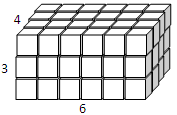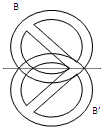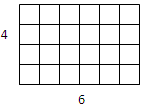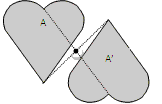Measurement
GM3-1: Use linear scales and whole numbers of metric units for length, area, volume and capacity, weight (mass), angle, temperature, and time.
This means students will recognise that length, area, volume and capacity, weight, angle, and temperature are the characteristics (attributes) of objects people most commonly measure in everyday life. Time is a special attribute since it is not tangibly attached to physical objects. Measurement involves quantifying an attribute using units. Units of measure have characteristics including being a part of the attribute they measure and uniformity (same size). When measuring, the units need to fill a length, space, time etc., with no gaps or overlaps (this is known as tiling). At Level Three, students should be familiar with common units in the metric system for the attributes listed. These units include metres, centimetres, millimetres, and kilometres for length/distance, square and cubic centimetres, and metres for area and volume, kilograms and grams for weight, quarter and half turns for angles, degrees Celsius for temperature, and seconds, minutes, hours, days, etc for time. It is not expected that students will know the size relationships between measures though they should have opportunities to explore these relationships, for example 15cm = 150mm. Using measurement instruments involves reading linear scales (an analogue clock face is three connected linear scales). Students should understand that the marks on a linear scale show the endpoint of units and that scales always have a baseline (zero). Part of measurement is selecting the scale, with the precision of unit, suitable for a task. Level Three students should apply their additive and multiplicative number strategies to measurement problems that involve whole numbers of units, for example how many cubic centimetres will fit in this packet? Supporting teaching resources.
GM3-2: Find areas of rectangles and volumes of cuboids by applying multiplication.
This means students will begin by measuring the areas of rectangles and other shapes using square units. This is because square units of the same size tessellate, that is join together with no laps or overlaps. That means that the measurement is consistent whereas the use of a non-tessellating unit would give variable results due to gaps and overlaps. Similarly, volume is measured in cubes of the same size. At Level Three students should apply whole number multiplication to make the process of counting squares or cubes more efficient. Supporting teaching resources.
|
|
 |
|
4 x 6 = 24 square units |
3 x 4 x 6 = 72 cubic units |
Click to download a PDF of second-tier material relating to Level 3 Measurement (354KB)
Shape
GM3-3: Classify plane shapes and prisms by their spatial features.
This means students will be able to define the characteristics of things and use these characteristics as a basis for sorting. Plane figures are those that lie flat, so have only two dimensions. So circles, triangles, and hexagons are all plane shapes. At Level Three students should be able to classify plane shapes by the following characteristics: number of sides and angles (for example all triangles have three sides), parallel or non-parallel sides (for example a trapezium has one pair of parallel sides), equal or unequal side length, angle size (less than, equal to, greater than a right angle), lines of mirror symmetry and order of rotational symmetry (for example a square maps onto itself four times in a full turn). Prisms are solid shapes that have a fixed cross-section. A loaf of bread can be seen as a rectangular prism since the slices are the same rectangle. So prisms are classified by their cross-section, for example a triangular prism has triangular cross-sections. In this way a cylinder can be seen as a type of prism though its cross-section is a circle. Supporting teaching resources.

GM3-4: Represent objects with drawings and models.
This means students will make drawings of objects, which can take the form of plan views or nets.
.gif)
Note that a net is a flat shape that folds to form a solid. Many different nets form the same solid, for example there are eleven different nets that form a cube. At Level Three students need to create two-dimensional drawings of three-dimensional models, as above, and be able to recreate the model when given another person’s drawings of it. Models may be built with interlocking cubes, plasticine, connecting geometric shapes or other materials, for example toothpicks and plasticine. Supporting teaching resources.
Click to download a PDF of second-tier material relating to Level 3 Shape (95KB)
Position and orientation
GM3-5: Use a co-ordinate system or the language of direction and distance to specify locations and describe paths.
This means students will use grid references or coordinates given on maps to specify location (for example Greensborough Reserve is at D1). They will also be able to describe direction (for example, Ruakura Road runs West-East) and distance (the scale of a map indicates distance).

At Level Three students should be able to:
- Give the location of something using grid references, for example A3.
- Find the location of something given a grid reference, for example Find Daphne Street at E8.
- Use features of a map to describe movement that would get someone from one location to another, including distance and direction. This includes turns (right, left relative to orientation), main compass directions (N,W,S,E) and approximate distances in metres or kilometres.
- Follow a set of directions given in terms of turns and distances (as above) and show that path they walked on a map of the area.
Supporting teaching resources.
Transformation
GM3-6: Describe the transformations (reflection, rotation, translation, or enlargement) that have mapped one object onto another.
This means students will explore and describe transformations. “Transformation” is a generic term used to describe actions on shapes that result in some form of pattern, usually symmetric. A reflection is the image of a shape as seen through a mirror line either inside or outside the shape, sometimes called a “flip”. A rotation is the image of the shape turned about a point either inside or outside the shape. A translation is the image of a shift of the shape along a line, and an enlargement is the image of the shape made bigger or smaller by some scale factor. At Level Three students should be able to compare the image of a shape with the original and describe the transformation. This can include a sequence of two transformations. For example:
|
|
 |
|
|
A' is the image of A |
B' is the image of B |
C' is the image of C |


